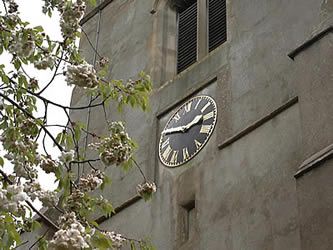Towering clock faces, like Grantchester’s Church Clock, Bangalore’s St Andrew’s Church Clock and Toronto’s Soldiers’ Tower symbolise history, time flow, and the past, reminding us of the future’s possibilities, says Saeed, exclusively on Different Truths.
In Greek mythology, ancient philosophy, and literature, the god of Time was Chronos. He was supposed to rule the cosmos and be the embodiment of time and its eternal flow. Among the deities of ancient Egypt was Thoth, the god of the moon, who was meant to control space and time. In the modern age, the concept of time, which moves ever forward, has been personified as Father Time, an old man, usually in a white robe, having a white beard, and carrying a scythe.
Over the years, writers and poets have expressed the permanence of time in various terms.

PC: poetryatlas.com
Over the years, writers and poets have expressed the permanence of time in various terms. It has been said that time never stands still, time waits for no man, time marches on, time is everlasting etc. For me, I see the constancy of time and its poetic expression in the many beautiful clock towers, some of them centuries old, that one sees all around the world. Here are three of my favourites.
“Yet stands the Church clock at ten to three? And is there honey still for tea?”
These well-remembered and well-loved closing lines from Rupert Brooke’s nostalgic poem “The Old Vicarage Grantchester,” have brought worldwide fame to the charming village of Grantchester, about three miles from Cambridge city. The clock is housed in the tower of the medieval Church of St. Andrew and St. Mary, parts of which date back to the 14th and 15th centuries.
Rupert Brooke (1887-1915) wrote this sentimental eulogy to the village of Grantchester in 1912 during his stay in Berlin.
Some cynics point out that the clock has been permanently stopped at ten to three…

PC: stadrews.org.in
Some cynics point out that the clock has been permanently stopped at ten to three for the benefit of the vast number of tourists who flock to Grantchester each year. Others have wryly suggested that the poet chose the time because it gave him a matching rhyme. Be that as it may, having visited Cambridge and the nearby village of Grantchester, I can vouch for the fact that the clock is in perfect working order, and if you time your visit appropriately, you can see the hands of the clock reach ten to three.
St. Andrew’s Church, located on Cubbon Road in Bangalore, is one of the prominent landmarks of the city. Consecrated in November 1866, this historical Presbyterian church built in the orthodox Scottish architectural style, is an imposing brick-coloured gothic structure 43 ft in height with a tall belfry and chiming clock at the apex of its tower. Notable features of the church are the richly ornate pulpit, the beautiful 25 ft. high stained-glass window above the altar and the heritage pipe organ.
The church bell has been ringing at 9.30 am every Sunday for over 150 years and the clock, installed in 1893, unfailingly chimes the quarter hour.
The 143 ft high Soldiers’ Tower is situated at the western end of Hart House.

PC: alumni.utoronto.ca
The 143 ft high Soldiers’ Tower is situated at the western end of Hart House. This bell and clock tower commemorates members of the university who lost their lives in the two World Wars. They have been honoured with their names etched in stone in the tower’s archway.
As time marches inexorably on, the charm of these towering testimonials continues to enchant us, unfailingly symbolising the perpetuity of Time.
As one poet so fittingly put it:
“For men may come and men may go, but I go on forever.”
Picture courtesy: standrewschurch.org.in, alumni.utoronto.ca, and poetryatlas.com
Feature picture design Anumita Roy





 By
By

 By
By
 By
By
The three clock towers are the erudite writer’s pretext to capture time for the reader!